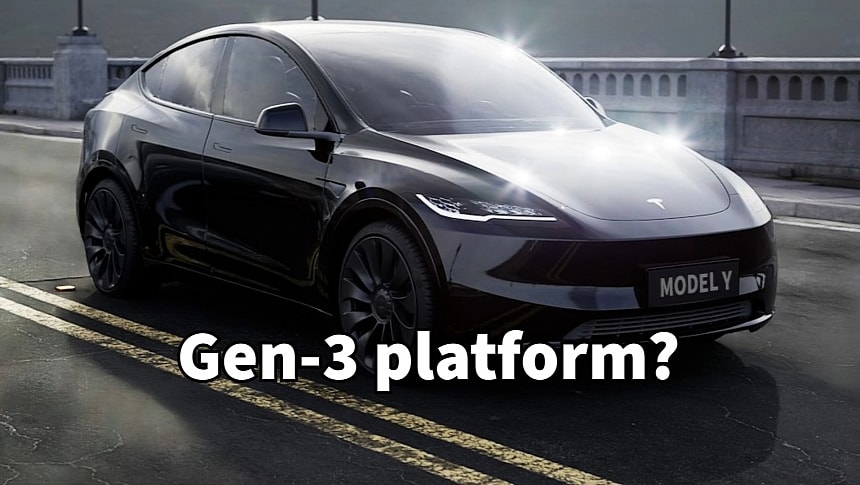Tesla hinted at accelerating new model launches by adding elements of the next-generation architecture to the existing models. This will allow Tesla to use existing production lines while honing the unboxed vehicle process for the upcoming robotaxi. The move explains why the Model Y refresh was delayed and shows that Tesla is still years away from launching its first unboxed-vehicle production line.
After finally caving into launching an affordable EV that would sell for around $25,000, Tesla announced a revolutionary "unboxed-vehicle" manufacturing process. This would allow Tesla to cut production costs in half compared to the Model 3/Y platform. The unboxed process was supposed to be instrumental to the success of Tesla's Gen-3 architecture. One year ago, during Investor Day, Tesla announced it would set up a new gigafactory in Mexico using the new manufacturing tech.
However, last year, Tesla switched its plans again and announced that the unboxed process would be first implemented at Giga Texas. Tesla explained this decision as a way to avoid delays at Giga Mexico and start next-gen vehicle production earlier than initially planned. So, all good. However, the release of the FSD V12 made Elon Musk change his mind again, and now only the robotaxi is planned to use the unboxed vehicle manufacturing process. This made some news outlets sound the knell for the $25,000 compact EV Tesla was working on.
However, the first quarter earnings call offered a different perspective on Tesla's plans. The shareholder deck revealed that Tesla is planning to begin production of new vehicle models, including more affordable EVs, earlier than previously announced. To make this possible, Tesla will skip the unboxed manufacturing process and mix the old (Gen-2) architecture with the new (next-gen) architecture. Instead of starting production in the second half of 2025, the next-gen vehicles could arrive in early 2025 or late 2024. The unboxed process is still confirmed for Tesla's "purpose-built robotaxi product."
The advantage of this approach is that Tesla will be able to produce the next-gen EVs on the same production lines as the current S3XY models. Tesla also hints at freezing investments in new production facilities. Instead, the EV maker is looking to "fully utilize the current expected maximum capacity of close to three million vehicles" before investing in new manufacturing lines. Tesla admitted that this would probably result in less cost reduction than previously expected. The advantage is a higher vehicle volume and a "more capex efficient production during uncertain times."
The wording in the shareholder update implies that Tesla will launch more models using elements from the next-generation architecture besides the affordable compact EV. This all but confirms previous rumors that existing models will transition to Gen-3 architecture. The most likely candidate is the refreshed Model Y, codenamed Juniper, whose launch has been delayed. The change will allow Tesla to reduce costs and improve margins even with lower prices. Tesla might also use the next-gen platform to also accelerate the Roadster launch.
However, last year, Tesla switched its plans again and announced that the unboxed process would be first implemented at Giga Texas. Tesla explained this decision as a way to avoid delays at Giga Mexico and start next-gen vehicle production earlier than initially planned. So, all good. However, the release of the FSD V12 made Elon Musk change his mind again, and now only the robotaxi is planned to use the unboxed vehicle manufacturing process. This made some news outlets sound the knell for the $25,000 compact EV Tesla was working on.
However, the first quarter earnings call offered a different perspective on Tesla's plans. The shareholder deck revealed that Tesla is planning to begin production of new vehicle models, including more affordable EVs, earlier than previously announced. To make this possible, Tesla will skip the unboxed manufacturing process and mix the old (Gen-2) architecture with the new (next-gen) architecture. Instead of starting production in the second half of 2025, the next-gen vehicles could arrive in early 2025 or late 2024. The unboxed process is still confirmed for Tesla's "purpose-built robotaxi product."
The advantage of this approach is that Tesla will be able to produce the next-gen EVs on the same production lines as the current S3XY models. Tesla also hints at freezing investments in new production facilities. Instead, the EV maker is looking to "fully utilize the current expected maximum capacity of close to three million vehicles" before investing in new manufacturing lines. Tesla admitted that this would probably result in less cost reduction than previously expected. The advantage is a higher vehicle volume and a "more capex efficient production during uncertain times."
The wording in the shareholder update implies that Tesla will launch more models using elements from the next-generation architecture besides the affordable compact EV. This all but confirms previous rumors that existing models will transition to Gen-3 architecture. The most likely candidate is the refreshed Model Y, codenamed Juniper, whose launch has been delayed. The change will allow Tesla to reduce costs and improve margins even with lower prices. Tesla might also use the next-gen platform to also accelerate the Roadster launch.






